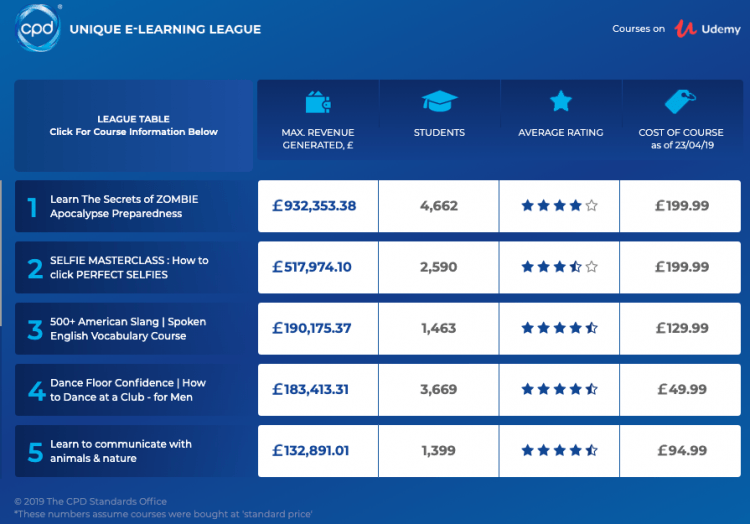5 Reasons You Should Market Your Nonprofit with Online Courses

These days, the power to educate is no longer reserved for only schools and training academies. Now, individuals can access a seemingly unlimited number of online courses on their own. And while online courses are a great way to learn new skills, they can also serve as a powerful marketing tool for your nonprofit.
Below, we’ll walk you through the benefits of using online courses in your marketing efforts to engage new audiences, boost awareness for your mission, establish your expertise, and encourage brand loyalty. Then, you’ll get some tips on how to get started creating your own course.
The Power of Online Courses
The success of an online course doesn’t necessarily depend on its title or subject field. Often, success comes through creative packaging of relevant information.
The CPD Standards office in the UK is a body that awards independent CPD accreditation to training and learning across all sectors. As such, they research the most unique online courses available to the public. They pulled their findings into a table of the top 10 one-of-a-kind online courses, covering everything from animal communication to rocket-building.
Their conclusions showed that over $2.5 million had been spent by students on creative courses which taught information that could be found for free across other popular channels such as YouTube.

The winner, the course that yielded the most revenue, is a course showing students how to survive a zombie apocalypse. It teaches basic, everyday survival: information which is readily available across the internet. The difference is that it was packaged into the creative concept of surviving a zombie apocalypse.
This course, in particular, tapped into new audiences using a creative concept, generated a wealth of brand awareness for the creators, and produced over $1 million in revenue. The best bit? The course has an average satisfaction rating of 4 out of 5 stars.

While your nonprofit may not be able to use an online course to generate revenue or fundraise directly, a free course can still provide countless other benefits when it comes to marketing your cause and engaging new audiences.
Marketing with Online Courses
Taking the zombie survival course as a model, creating an online course centered on your nonprofit’s cause category, mission, or work can help you stand out in a busy marketplace. For example, if your nonprofit focuses on sustainability and the environment, you could create a course titled “10 Ways to Save the Earth.”
In this course, participants could learn daily actions they can take to reduce their carbon footprint and be champions for your cause. It engages your target audience with relevant content, offers actionable insights, and provides a platform to market your nonprofit.
Here are five powerful reasons to incorporate online courses into your marketing strategy.
1. It’s Inexpensive to Run
One of the most attractive qualities of creating an online course is that it’s a highly cost-effective form of marketing. Furthermore, as everything is online, you likely won’t have to pay extra costs for any upkeep, such as the on-going production of learning materials or the cost of employing someone to create them.
Additionally, it can all be done using a smartphone and a piece of editing software. We’ll touch more on this a little later on, but the actual filming and editing of the course can be done far cheaper than you may have previously anticipated as well.
2. Drive Awareness
The internet is an incredible forum for reaching your target audience, but it is inevitably a noisy place and standing out can be difficult. To ensure people see your course, implement a multi-angled approach like creating a special landing page on your website, a social media marketing campaign, and an email newsletter to your audience. This helps to maximize the number of touchpoints that a potential user will have with your brand, increasing the opportunity for them to not only see your brand but take interest as well.
You can also drive awareness by publishing your course on Udemy to better your opportunity of reaching a new and previously untapped audience. Udemy attracts around 99 million monthly visits, but remember: the unique angle of your course will help differentiate you and drive more people your way.
3. Establish Your Expertise
High-quality online courses position you as an expert within your field. Further, it’s a medium that doesn’t immediately feel like a played-out marketing message to your audience.
Communicate a clear value to the target audience by providing relatable solutions to their problems. For example, if your course is about how to save the Earth, you can share data around the impact of your nonprofit’s work. Then, you can suggest they fundraise on your behalf through your DIY fundraising program.
In this scenario, you’re providing a key learning with the data and following up with an insight about how someone can take immediate action. Tactics like this can help establish your expertise from the first interaction, build trust with your audience, and spread the word about your work.
4. Encourage Brand Loyalty
Online courses are a great tool to help establish a relationship with prospective supporters and build loyalty towards your nonprofit’s brand. It opens up a new door for interactions with people who are already predisposed to support your brand, and helps you gather feedback easily and in real-time for implementing in future campaigns.
One way your online course can establish brand loyalty with your audience is through interactions with students. They may reach out to you with specific questions, so take the opportunity to assist or help them fully understand the coursework.
Your course also adds value to their lives and doesn’t necessarily make a direct “sale” to donate to your nonprofit. Thus, when the time comes for you to engage your online course registrants as potential fundraisers, donors, or volunteers, they’re already familiar with your brand and potentially more receptive to getting involved.
5. Stand Out from the Crowd
When it comes to online marketing, you must differentiate yourself if you want to outperform others in your sector. Aside from traditional marketing tactics, an online course is a different way to grab people’s attention and allow them to first learn about the subject matter they’re passionate about before getting to know you better as a nonprofit.
How Can You Get Started?
In the short-term, it may appear that starting an online course for your nonprofit is a mountainous task. However, you can create an online course with a thorough plan, video editing software, and a smartphone.
Make a Plan
Aim to lay out exactly what you want to communicate in your course and the value you want to provide. You can always pilot a shorter course to begin with, gauge the reaction, and add to it as its user base grows: create a minimum viable product (MVP) and go from there.
Then, you want to wrap your course in a creative concept. Research and explore news, current events, and media interest on topics relevant to your cause sector for ideas. Don’t overlook community forums either, as they can be a good source of popular opinion from within your audience demographic.
Film Your Content
Most smartphones these days come equipped with high-quality cameras, but you can also use an actual camera to film your content if you have access to one. Then, you will then need to select from a range of video editing tools depending on your budget. If you don’t need to make use of fancy graphics and features, then the standard free software should be more than sufficient.
Much of the video content you create will be evergreen and can be reused across other channels such as social media and email, so think of all this as an investment into creating an archive of video footage.
Sign up to Udemy for free
Launching your course across Udemy is free of charge, though they do have guidelines that must be met. You could also host the course on YouTube and gate it with an opt-in on your website.
The benefit of Udemy, however, is that you can continuously add and adapt your course as time goes on. Starting a small course with an innovative concept will allow you to gauge interest and react to what is demanded from your audience.
To recap, here’s a quick list of what we’ve discussed today:
- Your course doesn’t have to host the most unique content on the web, it just needs to wrapped in a creative concept. Ensure the concept blends into your offering and values as a nonprofit.
- Make a plan of the value you want to communicate to the students. Your goal here is to tap into an audience that wouldn’t usually see your marketing messages, tap into their curiosity.
- Grab yourself a smartphone, tripod and some freebie video editing software.
- Sign up to Udemy and run-through their quality guidelines.
- Create a smaller course and push it out to gauge reaction. Build it in your free time and publish an MVP version.
- Use the course content you have created across other marketing channels.
Let us know if you decide to use this marketing strategy for your nonprofit. We’d love to hear the results in the comments below—good luck!
Amanda Rosewarne has a background in occupational psychology, extensive experience in the CPD field, and is a unique expert on the provision of workplace training and CPD learning. As CEO and Co-Founder of the CPD Standards Office, she advises a multitude of organizations, from professional bodies, to corporate employers, to small training providers on ‘becoming CPD ready’ and implementing CPD best practice within their organizations.

9 Email Templates for Nonprofit Annual Communication Plan



